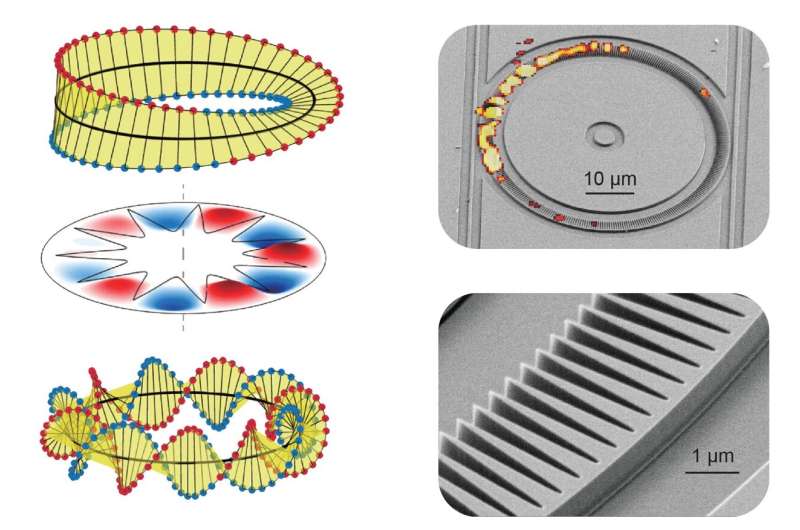December 1, 2022 feature
Whispering gallery modes with fractional optical angular momentum in photonic crystal micro-rings

Whispering gallery modes, a type of wave that can travel around concave surfaces, have proved to be promising for the development of new technologies, particularly in photonics. Due to geometrical limitations, in circularly symmetric optical microresonators (i.e., micrometer-scale structures that can confine light) these modes exhibit integer quantized angular momentum values. While numerous effects take advantage of such modes, there are applications for which non-integer angular momentum may be desired.
Researchers at the National Institute of Standards and Technology and University of Maryland have recently developed a unique photonic crystal micro-ring that enables whispering gallery modes with a fractional optical angular momentum. This ring-shaped structure, introduced in a Physical Review Letters (PRL), could open interesting possibilities for the creation of sensors, measurement tools, nonlinear optical devices, and other technologies.
"Our recent PRL paper builds on our previous work in Nature Photonics, where we introduced the structure of a 'microgear' photonic crystal ring," Xiyuan Lu, one of the researchers who carried out the study, told Phys.org. "In this new work, we demonstrate the half-integer orbital angular momentum of light, in comparison to the even numbers attained by the photonic crystal ring we previously studied, which gives integer orbital angular momentum of light similar to that it conventional micro-rings, referred to as 'whispering gallery modes'."
In their recent work, Lu and his colleagues set out to investigate new capabilities of the photonic crystal micro-rings introduced in their previous paper. The team also wished to explore how introducing multiple defects into their resonator would affect its localization capabilities and its spatial control of light.
"The meaning of 'half-integer angular momentum' is that light needs to make two round trips around the resonator to go get back to its initial phase (modulo 2*pi), which is different than the conventional micro-rings, where it takes just one round trip," Kartik Srinivasan, another researcher involved in the study, told Phys.org. "This is why our resonator has sometimes been compared to a Mobius strip."
To achieve half-integer angular momentum, the team simply designed their ring using an odd-number of periodic cells within its circumference, instead of choosing an even-number of cells. This allowed them to access the other half of the parameter space accessed by previously devised photonic crystal rings.
"The realization of the multiple defects in our device was also far from complicated, as we simply introduced multiple defect modulation across our ring," Lu said. "As a result of this unique design, we could achieve two functionalities, half-integer angular momentum or multiple defect localization, in silicon photonics, with a fabrication method that can be scalable."

In initial tests, the ring-shaped micro-resonator developed by this team of researchers achieved highly promising results, exhibiting a high-Q and good coupling. In addition, the device can be integrated with nonlinear photonics, quantum photonics and bio-sensing applications, just as easily as whispering gallery modes in conventional micro-rings are integrated.
Designing high-Q photonic crystals, including geometries that incorporate defects to strongly localize light, is typically challenging and time-consuming, as it entails running several simulations and completing various optimization steps. In contrast, the micro-ring created by Lu and his colleagues has a very simple and straightforward design, which does not need to be perfected through simulations and optimizations.
"We have seen that we can slow light down and highly localize it to within a small fraction of the ring (this was the focus of our earlier paper), and now we showed that we can create half-integer angular momentum states and multiple highly localized defect states in the same ring, and we can use those same defects to control the orientation of slow-light whispering gallery modes," Srinivasan said.
"While not every effect is available simultaneously, in some cases, we can combine effects or apply one effect for one mode and another effect for another mode, and most importantly, we know how to design and control the effects."
The two recent papers by Lu, Srinivasan and their colleagues show that the introduction of unique photonic crystal patterns in micro-ring resonators can profoundly alter the characteristics of electromagnetic fields. In the future, their resonator design and the resulting control of electromagnetic fields could help to tackle many research problems that involve light-matter interactions, for instance enabling the realization of multiple quantum nodes in a micro-ring or the nonlinear generation of light.
"One important point to me is that this work goes forward in one step in how to implement multiple quantum nodes in a microring, and particularly in raising a problem that the weak coupling of the defects can be non-negligible and need to be taken care of," Lu said. "This weak coupling is a bit surprising to me."
In their next studies, the researchers plan to test the value of their design to achieve control over electromagnetic fields interacting with matter. More specifically, they plan to apply it to the development of nonlinear optical technologies and quantum optics made of atoms or quantum dots.
"We are interested to investigate the origin of the weak coupling, in order to control it better down the road," Lu said. "We are also looking into nonlinear optical interaction with the localized modes and quantum interaction with atoms and quantum dots in these devices."
More information: Fractional optical angular momentum and multi-defect-mediated mode renormalization and orientation control in photonic crystal microring resonators. Physical Review Letters(2022). DOI: 10.1103/PhysRevLett.129.186101
High-Q slow light and its localization in a photonic crystal microring. Nature Photonics(2021). DOI: 10.1038/s41566-021-00912-w
Journal information: Nature Photonics , Physical Review Letters
© 2022 Science X Network





















